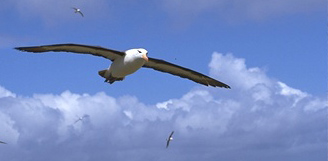Vertebrate Flight
THE ORIGINS OF FLIGHT (a.k.a. TWO WINGS AND A PRAYER)
 Black Browed Albatross. Photo by Gerald and Buff Corsi; © 2003 California Academy of Sciences. |
|
Okay, now you might be saying: "Enough with the procedure. Give us some hypotheses; tell us what scientists think!" We'll do just that. We are following a simple train of thought; using a wing origin hypothesis from the previous exhibit, we adopt a hypothesis of how flight evolved (its evolution) along with the wings, and then propose an evolutionary hypothesis to explain why it evolved (its origin).
The Flight Debate
A debate that has continued since the 1880s concerns the question of whether flight developed from the ground up (did flight evolve from a bipedal, cursorial, ground-dwelling ancestor?) or from the trees down (did flight evolve from a semi-bipedal, arboreal, leaping and gliding ancestor?). This debate will no doubt continue, however, it is a pointless debate, as neither hypothesis is testable. The important question is, how did the flight stroke evolve?
Why Did Flight Evolve?: Several Main Hypotheses
- To help escape from predators
To help catch flying or speedy prey
To help move from place to place (leaping or gliding)
To free the hindlegs for use as weapons
To gain access to new food sources or an unoccupied niche
These hypotheses also cannot be tested directly. They are interesting ideas, and some may even be right. But we really can't conceive of finding real evidence that will decide the plausibility of these hypotheses.
Flight Origins: Summation
The problem is not whether flight evolved on the ground or in the trees, but how the flight stroke evolved. Without this stroke, you can't fly. So, we study this question by a series of steps. We define what flight is; that is, what features you need to fly. Then, using a cladogram of the flying animals and their closest relatives, we analyze the sequence of assembly of these features, and then infer what these structures were doing when they first evolved.